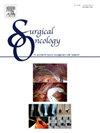在接受根治性治疗的食管癌患者中,ct定义的体成分与预后的相关性
IF 2.4
4区 医学
Q3 ONCOLOGY
引用次数: 0
摘要
身体组成,包括由骨骼肌指数(SMI)定义的低骨骼肌质量(LSMM)以及皮下和内脏脂肪组织(SAT和VAT),可以使用横断面成像技术进行评估。先前的研究显示了对包括食管癌(EC)在内的几种肿瘤实体的有希望的预后价值。本研究的目的是分析食管癌患者接受根治性治疗时身体成分参数的可能关联。方法回顾性分析2016年至2023年期间所有接受根治治疗的EC患者。共纳入145例患者,其中女性17例,占11.7%,平均年龄65.9±10.2岁。对于所有患者,分期计算机断层扫描(CT)用于计算LSMM, VAT和SAT。主要研究终点是全因总生存期。统计分析采用Mann-Whitney检验计算组间差异。采用Kaplan-Meier曲线和多变量Cox回归分析检验体成分参数对死亡率的影响。结果观察期内共有51例(35.2%)患者死亡。根据SMI的肌少症阈值,99例(68.2%)归为肌少症,根据VAT阈值,102例(70.3%)归为内脏型肥胖。单变量分析中,肌肉减少症和内脏肥胖与死亡率相关,风险比(HR)分别为2.05(95%可信区间(CI) 1.17, 3.57, p = 0.01)和2.47 (95%CI 1.39, 4.37, p = 0.002)。在多变量分析中,只有两者结合,肌肉减少性肥胖才有显著相关性(HR 2.47, 95% CI 1.39; 4.37, p = 0.002)。结论ct定义的肌肉减少症和内脏性肥胖的结合在行根治性切除的EC中显示出很强的预后相关性。单独考虑肌肉减少症和内脏性肥胖的影响,其预后意义较小。在临床实践中,ct定义的身体成分可能有助于更好地对预后较差的EC患者进行分层。本文章由计算机程序翻译,如有差异,请以英文原文为准。
Prognostic relevance of CT-defined body composition in esophageal cancer patients undergoing curative treatment
Introduction
Body composition including low skeletal muscle mass (LSMM) defined by skeletal muscle index (SMI) and subcutaneous and visceral adipose tissue (SAT and VAT) can be assessed using cross-sectional imaging techniques. Previous studies have shown promising prognostic value for several tumour entities, including esophageal cancer (EC). The aim of this study was to analyse possible associations of body composition parameters in patients with esophageal cancer undergoing curative treatment.
Methods
All patients with EC undergoing curative treatment were retrospectively evaluated between 2016 and 2023. A total of 145 patients (17 female, 11.7 %) with a mean age of 65.9 ± 10.2 years were included in the present analysis. For all patients, staging computed tomography (CT) was used to calculate LSMM, VAT, and SAT. The primary study end point was all-cause overall survival. For statistical analysis group differences were calculated using the Mann-Whitney test. Kaplan-Meier curves and multivariable Cox regression analysis was used to test the effect of body composition parameters on mortality.
Results
In total, 51 patients (35.2 %) of the patient cohort died within the observation period. According to the sarcopenia threshold of the SMI, 99 patients (68.2 %) were classified as sarcopenic and according to the VAT threshold, 102 patients (70.3 %) were classified as visceral obese. Sarcopenia and visceral obesity were associated with mortality with a hazard ratio (HR) of 2.05 (95%confidence interval (CI) 1.17, 3.57, p = 0.01) and 2.47 (95%CI 1.39, 4.37, p = 0.002) in univariable analysis, respectively. Only the combination of both, sarcopenic obesity was significantly associated in multivariable analysis (HR 2.47, 95 %CI 1.39; 4.37, p = 0.002)
Conclusions
The combination of CT-defined sarcopenia and visceral obesity showed a strong prognostic relevance in EC undergoing curative resection. The effect of sarcopenia and visceral obesity considered separately was of lesser prognostic significance. CT-defined body composition may help to better stratify patients with EC at risk of worse outcome in clinical practice.
求助全文
通过发布文献求助,成功后即可免费获取论文全文。
去求助
来源期刊

Surgical Oncology-Oxford
医学-外科
CiteScore
4.50
自引率
0.00%
发文量
169
审稿时长
38 days
期刊介绍:
Surgical Oncology is a peer reviewed journal publishing review articles that contribute to the advancement of knowledge in surgical oncology and related fields of interest. Articles represent a spectrum of current technology in oncology research as well as those concerning clinical trials, surgical technique, methods of investigation and patient evaluation. Surgical Oncology publishes comprehensive Reviews that examine individual topics in considerable detail, in addition to editorials and commentaries which focus on selected papers. The journal also publishes special issues which explore topics of interest to surgical oncologists in great detail - outlining recent advancements and providing readers with the most up to date information.
 求助内容:
求助内容: 应助结果提醒方式:
应助结果提醒方式:


